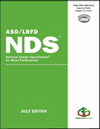History of the Development of a National Standard of Practice for Wood Design
 From time-to-time you might see the term NDS® (National Design Specification® for Wood Construction appear in my blogs, and it is referenced on every set of Hansen Pole Buildings plans, as well as within the International Building Codes.
From time-to-time you might see the term NDS® (National Design Specification® for Wood Construction appear in my blogs, and it is referenced on every set of Hansen Pole Buildings plans, as well as within the International Building Codes.
Me, being the curious sort, wanted to know the history of the NDS® and I was able to find it in the 1997 NDS® commentary. I felt it interesting enough to share:
In the early part of the century, structural design with wood was based on general engineering principles using working stresses or design values published in engineering handbooks and in local building codes. These design values were often not in agreement, even for the same species of wood. Further, on most cases, the assigned values were not related to lumbar grade or quality level.
To meet the growing need for a national standard of practice, the Forest Products Laboratory, an agency of the Forest Service, U.S. Department of Agriculture, prepared a guide for grading and determining working stresses for structural grades of timber.
It provided basic working stresses for clear, straight-grained material of the important commercial species and presented strength ratios for adjusting basic strength values for each species for the effect of any size and location of knots or other natural characteristics permitted in a structural grade. The basic stresses and the strength ratios established in Miscellaneous Publication 185 were based on extensive test data for small, clear specimens and structural timbers obtained from over twenty years of testing and evaluation at the Forest Products Laboratory.
In 1934, the National Lumber Manufacturers Association (now the American Forest & Paper Association assembled the information given in Miscellaneous Publication 185 and working stresses derived therefrom together with engineering equations and other technical information on wood in the publication “Wood Structural Design Data” (WSSD) Included as supplements to the publication was design information for timber fastening. A major component of the WSSD was extensive span and load tables for various sizes of timber beams and columns.
With the initiation of World War II, the need for a comprehensive national design standard for timber structures, including wood connections, became more urgent. The Technical Advisory Committee of the National Lumber Manufacturers Association undertook a more than three year effort to develop the necessary specification in close consultation with the Forest Products Laboratory. The result was The Specification for the Stress-Grade Lumber and It’s Fastening. The Specification included allowable unit stresses fort stress graded lumber, design formulas, and design loads and provisions for timber connector, bolted, lag screw, nail and wood screw joints. Also included were guidelines for the design of glue-laminated structural members.
Despite numerous revisions since 1944, the scope of the Specification has remained essentially unchanged.
To an increasing degree in recent years, the results of research conducted at universities and other private and public laboratories, in Canada and other countries as well as the U.S.have been utilized to improve the Specification as a national standard of practice for wood construction.
In 1992 NFPA (National Forest & Paper Association) was accredited as a canvass sponsor by the American National Standards Institute (ANSI). The Specification subsequently gained approval as an American National Standard with an approval date of October 16,1992.
And there you have it, years of testing and revisions to the Specification, which is the basis for the engineering which goes into every Hansen Pole building kit package.
For those who want or need to know more, visit this website which has the full story of the history of a National Standard of Practice for Wood Design:
https://www.awc.org/pdf/codesstandards/publications/nds/archives/Part00CoverAndHistorypp1to3.pdf






